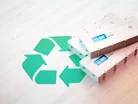The logistical challenges of lithium-ion battery recycling

Zachary Baum is an expert in lithium-ion recycling plants. He understands the complications of building such a plant, why these batteries are complex to recycle and the consequences of not recycling lithium-ion batteries.
Baum has a PhD in Inorganic Chemistry from The Ohio State University. Since he joined CAS, Baum is able to apply his interdisciplinary understanding to the analysis of photochemistry and energy technology literature.
Information Technology and Service CAS is headquartered in Columbus, Ohio and was founded in 1907. CAS curates and analyses scientific knowledge, to discover connections that could lead to breakthroughs.
What are the main complications of building a lithium-ion battery recycling plant?
Zach: “When building a lithium-ion battery plant, there are many challenges to consider, but three of the most important ones include: ensuring safe transportation to and from the facility, maximising the economic value of the recycled metals, and addressing the design variability from a scientific and process perspective. Balancing all of these issues can make it extremely difficult for battery recycling to be both environmentally efficient and profitable.”
What is it about lithium-ion battery recycling that is so challenging?
Zach: “Beyond the logistical challenges of safely and economically transporting large, dense lithium-ion batteries (such as those from electric vehicles) to a recycling facility – the root of the challenge technically is in efficiently extracting the most valuable metals. That process, including disassembly, separation, and recovery, requires significant scientific, engineering, and facility investments to do profitably at scale.
“Batteries are not typically designed with disassembly and recycling in mind, so crushing the device whole is often required to get to the most valuable materials. Then, the powdered solid materials used in batteries must be separated based on subtle differences in physical and chemical properties. The cost associated with these physical and chemical separations (reagents, energy input, facility development, pollution mitigation) represent a sizeable barrier to entry for the prospective battery recyclers.
“The science behind recycling is advancing quickly to simplify this process and make it more efficient and safer, as well as to minimise the environmental impact. These advances will drive the economics for recycling lithium-ion batteries in the future.”
Why has it taken so long for such a facility to be built?
Zach: “It is not surprising that we are only just seeing the development of lithium-ion battery recycling facilities, as the decision to invest in infrastructure such as a battery recycling facility is primarily driven by demand and economic incentives.
“We are now approaching that tipping point in the volume for li-ion batteries, and it’s only going to increase with the influx of new electric cars that will be launched in the coming years, and the on-going disposal of consumer sized batteries from phones and handheld electronics.
“However, with multiple other emerging battery technologies as well as those currently in use, the variability in battery chemistry and device design makes the creation of a standard processing stream for recovering most battery components difficult. A process that works for recovering metals from one type of battery may not work for all others. This reality requires flexibility in facility design, but also creates uncertainty that can hinder investment in recycling infrastructure as battery technology continues to evolve rapidly.”
Why do we use lithium-ion batteries if we don’t have a way to recycle them?
“Lithium-ion batteries are a popular battery choice, as they have several advantages over other types of batteries. They offer the highest energy density among rechargeable batteries and deliver more current (up to 3.6 volts). They have also proven to require little maintenance and have a long shelf life. While lithium-ion batteries do contain nickel, cobalt, and manganese, they are significantly less toxic than their lead acid counterparts found in most vehicles today, and these metals offer the potential to retain their value for reuse if properly recycled.
“The emergence of alternative chemistry approaches for batteries such as lithium-iron-phosphate (LFP) cathodes (made without nickel or cobalt) demonstrate how innovation efforts are creating cheaper, more stable, and less risky solutions to address both the power and recycling aspects of this challenge. In fact, Tesla has recently announced a decision to switch to this technology in their lower range cars.”
How will the lithium-ion battery market grow and mature in the next 5-10 years?
Zach: “There are significant growth projections for the lithium-ion battery market – according to Research and Market’s Global Forecast, it is expected to grow at a 12.3% CAGR from 2021 to 2030, to be valued at over £86bn.
“However, in recent years, the significant increase in public research and especially patent applications in CAS’s latest white paper for lithium-ion recycling technology suggests that recycling is positioned for growth to meet this future demand.”
What are the main supply chain challenges when recycling lithium-ion batteries?
Zach: “From a supply chain perspective, there are two critical challenges. First is the transportation of end-of-life batteries from disposal sites to a recycling facility, which can be expensive if long distance or international transport is required.
“The second is the safe handling of a 1,000 pound, highly flammable EV battery. Only then, does the actual extraction and recycling process begin, where there are additional supply chain challenges for materials, so optimisation of both the supply chain and recycling processes will be critical for efficient and profitable recycling.”
- Digitalisation as a Strategy to Attract and Retain WorkersDigital Factory
- UPDATED VENUE & DATE – Manufacturing LIVE Chicago 2025Sustainability & ESG
- ABB Cuts Industrial E-Waste in Quest for CircularitySustainability & ESG
- Why Are Manufacturers Doubling Down On Digital Twins?Digital Factory

